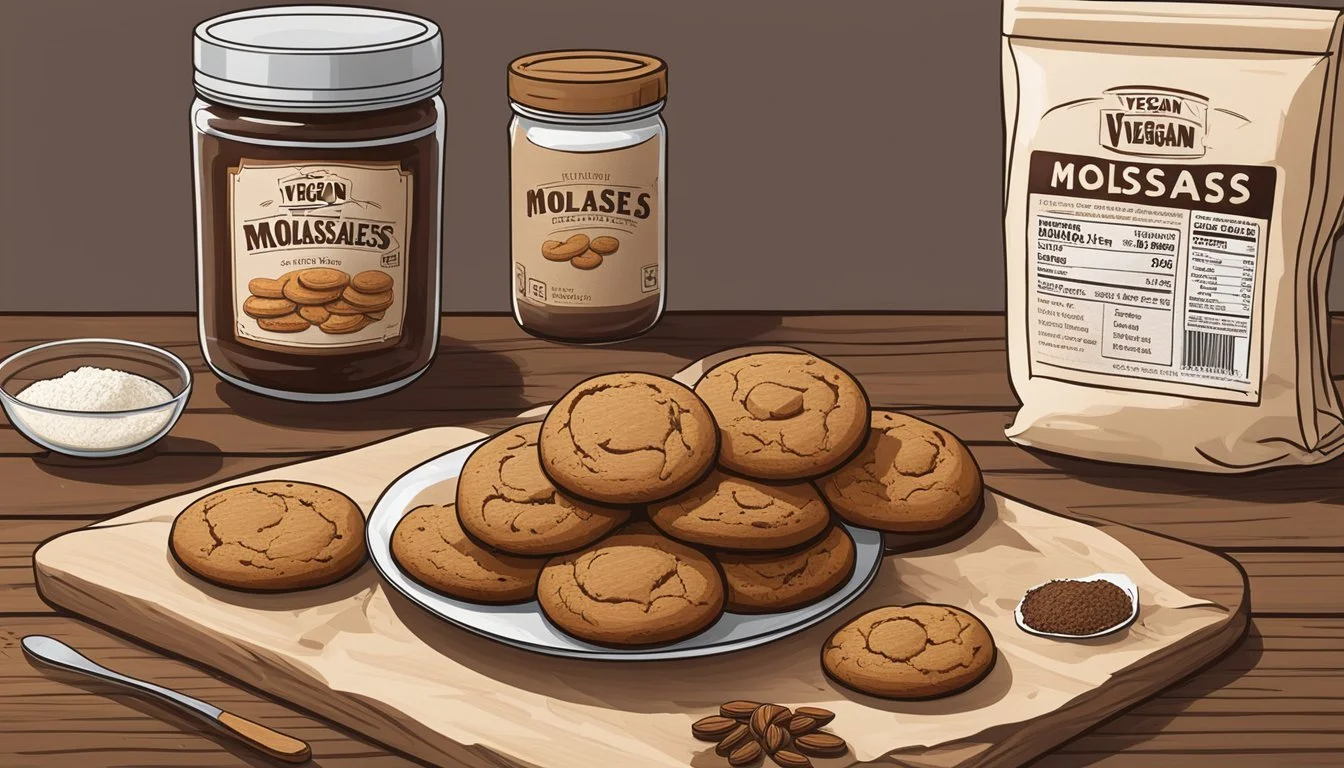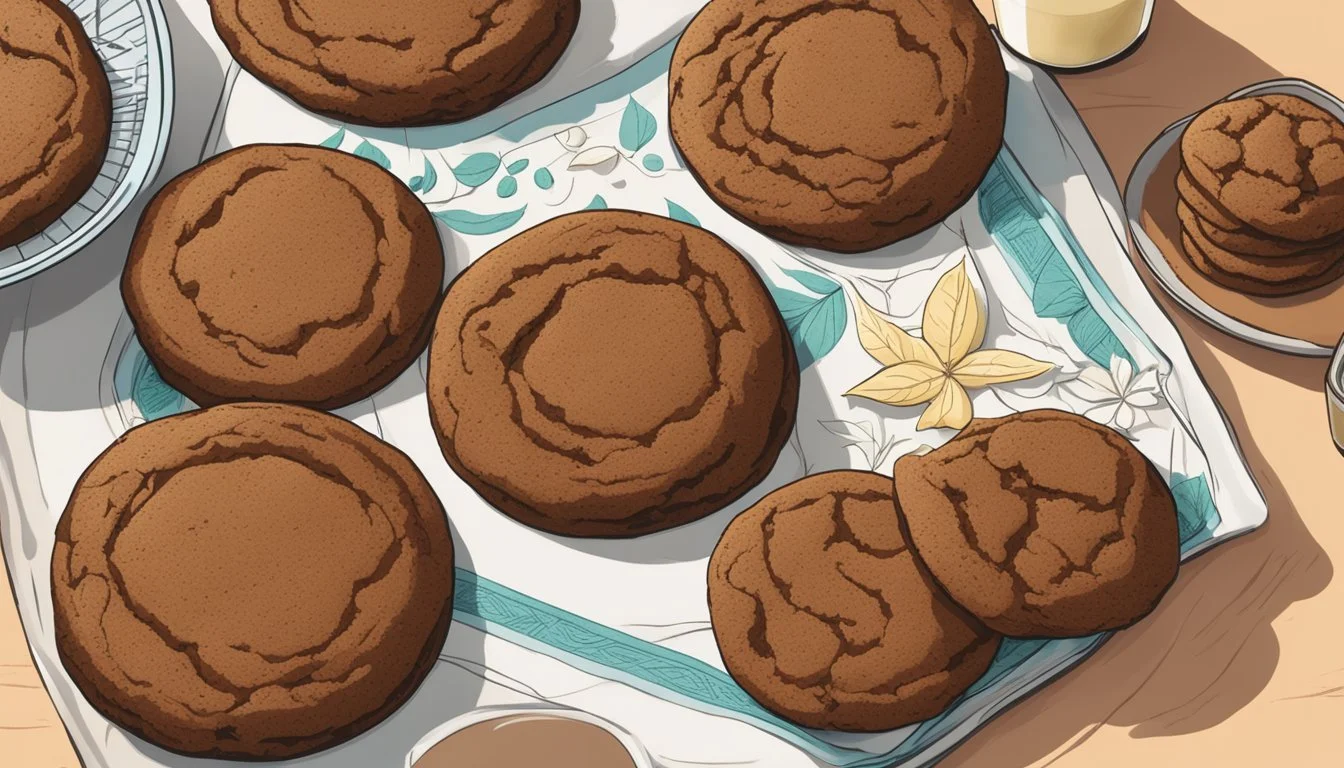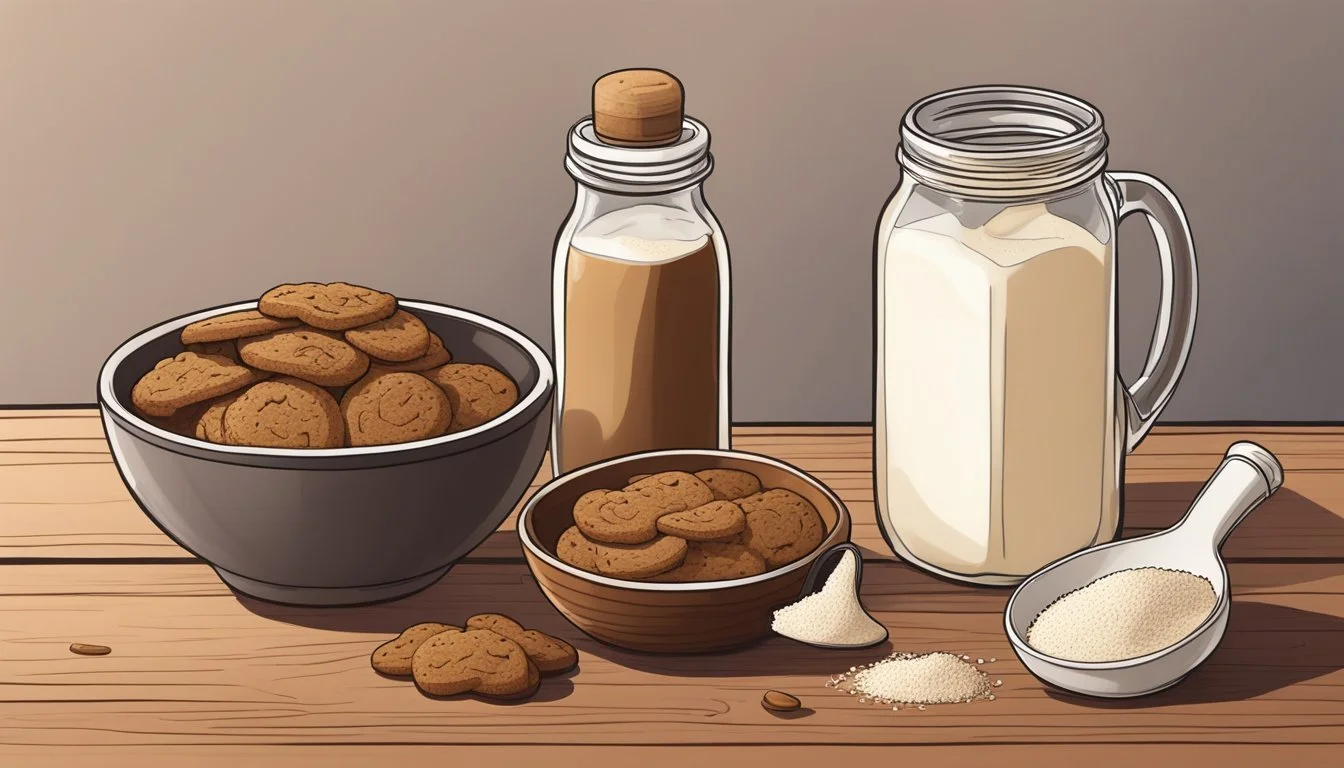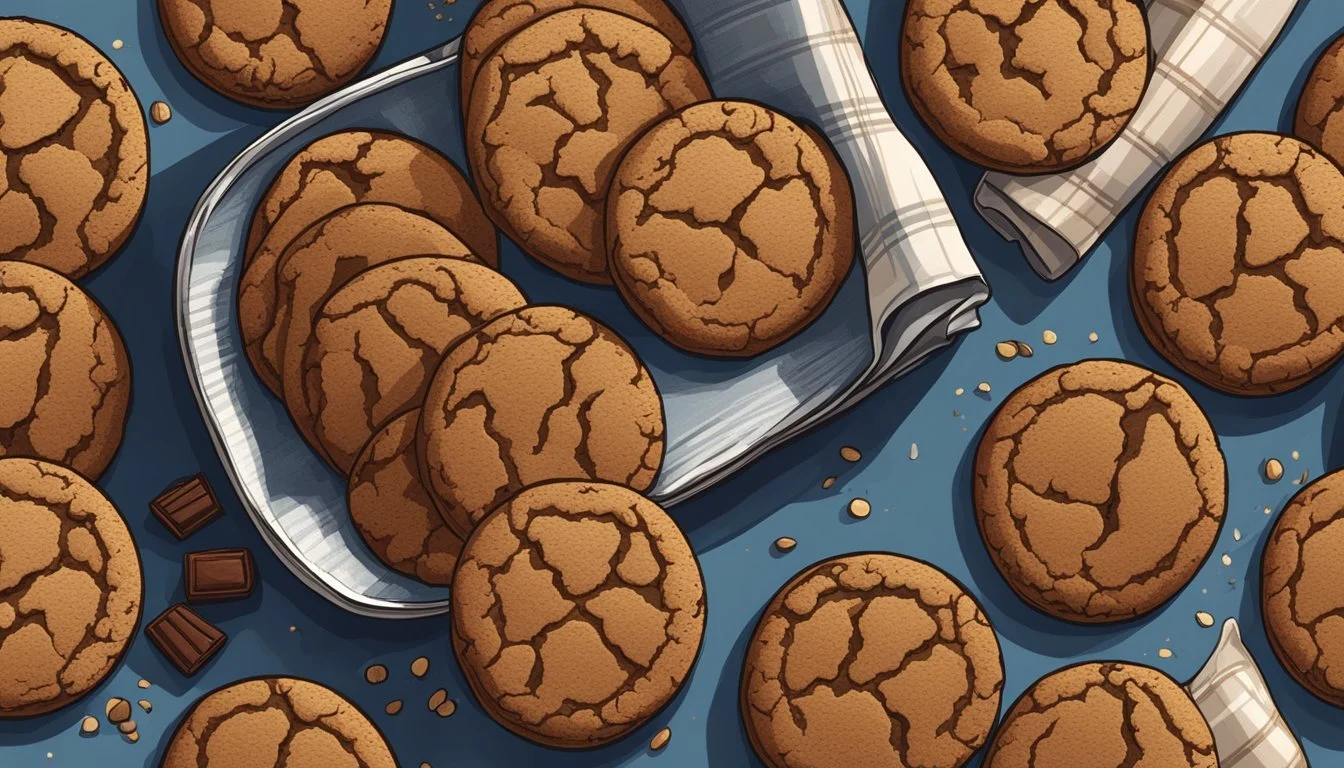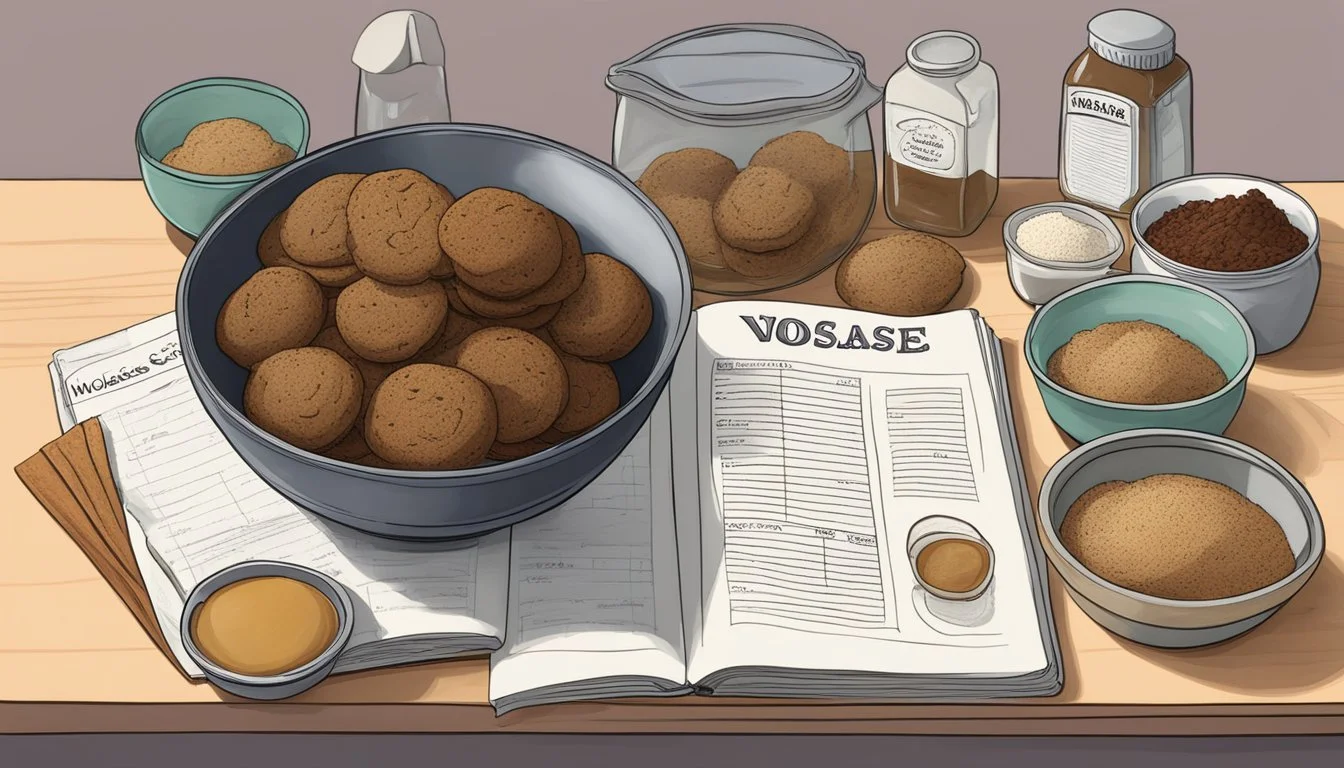Are Molasses Cookies Vegan?
Determining Their Dietary Compliance
Molasses cookies are a classic treat, rich in flavor from the robust, sweet syrup known as molasses. Traditionally, these cookies may contain ingredients such as eggs, butter, or other dairy products, which are not vegan-friendly. However, with the rising popularity of vegan diets, there has been a surge in the demand for plant-based versions of beloved desserts, including molasses cookies.
When adapting molasses cookies for a vegan diet, eggs can be replaced by substitutes such as flaxseed meals or commercial egg replacers, and butter can be swapped for plant-based alternatives like vegan butter or coconut oil. The key ingredient, molasses, is naturally vegan as it is derived from the sugarcane plant. By carefully selecting ingredients, bakers can create molasses cookies that are fully vegan without sacrificing the rich, chewy texture and deep, spicy flavors that make these cookies a year-round favorite.
The market today offers a variety of vegan molasses cookie recipes and pre-made options that ensure those following a vegan lifestyle do not have to miss out on this timeless confection. Recipe creators have fine-tuned their approaches to cater to vegan preferences, employing innovative plant-based solutions without compromising the cookie's signature taste. Vegan molasses cookies are not only possible but have become a widely enjoyed alternative in the realm of sweet treats.
Understanding Veganism
Veganism is more than a diet, it's a lifestyle choice that excludes all forms of exploitation and cruelty to animals for food, clothing or any other purpose. Within the context of food, it involves evaluating ingredients and methods to ensure they align with vegan principles.
Defining Vegan Ingredients
Vegan ingredients are those that do not originate from animals and have not been involved in animal exploitation or cruelty during their production. A comprehensive list of vegan ingredients would be extensive, but major categories include:
Fruits and Vegetables: All naturally vegan and used in a wide array of dishes.
Grains: Such as rice, wheat, quinoa, and barley.
Legumes: Including beans, lentils, and chickpeas.
Nuts and Seeds: Almonds, flaxseeds, and chia seeds are a few examples.
Plant-Based Milks: Soy, almond, rice, and oat milks are common dairy alternatives.
Sweeteners: Certain syrups and non-bone char processed sugars.
These ingredients are the foundation of vegan cooking and baking, utilized to create dishes that would traditionally depend on animal-derived components.
Common Non-Vegan Ingredients
Conversely, ingredients that are not vegan tend to come from animals or are animal byproducts. Some of the most common non-vegan ingredients include:
Dairy Products: Such as milk, cheese, butter, and yogurt.
Eggs: Used in many baking recipes for binding and leavening.
Honey: An animal-derived sweetener produced by bees.
When preparing vegan meals, these ingredients must be substituted with plant-based alternatives to remain consistent with vegan ethics. For instance, dairy milk can be replaced with almond or soy milk, butter with plant-based oils or margarine, and eggs with flax or chia seeds mixed with water. It's essential for vegans to thoroughly check product labels for these non-vegan ingredients and their derivatives.
Molasses Cookies Overview
Molasses cookies are a classic treat known for their rich flavor profile and distinctive chewy texture. They are typically made with molasses and brown sugar, contributing to their moist and soft qualities.
Traditional Molasses Cookies Ingredients
Molasses is the key component of molasses cookies, imparting a deep, caramelized flavor that is both sweet and slightly bitter. Traditional recipes often include:
Molasses: A thick syrup that results from refining sugarcane or sugar beets into sugar.
Brown Sugar: Contributes to the moisture and flavor.
Butter: For richness and tender texture.
Flour: The structural base of the cookie.
Eggs: Often used as a binder in the dough.
Spices: Such as cinnamon, ginger, and cloves, which provide the signature warm spiciness.
Leavening Agents: Typically baking soda, to help the cookie rise.
Characteristics of Molasses Cookies
Molasses cookies are recognized for their:
Texture: The cookies are usually soft and chewy, a result of the high moisture content from molasses and brown sugar.
Flavor: They feature a robust flavor with notes of caramel and spices.
The chewiness of molasses cookies is often enhanced when the dough is chilled before baking, which allows the fats to solidify, leading to less spread during baking and a denser texture.
Vegan Baking Essentials
When it comes to baking vegan cookies, such as vegan molasses cookies, using the right substitutes and ingredients is crucial for achieving the desired taste and texture.
Vegan Substitutes for Baking
Vegan baking often involves replacing traditional dairy and egg components with plant-based alternatives. Vegan butter is a staple substitute for regular butter, providing the necessary fats for richness and a tender crumb. It can be used in the same quantities as dairy butter. For eggs, options like flaxseed or chia mixed with water can provide the binding quality needed in baked goods like vegan chocolate chip cookies.
Common vegan substitutes:
Butter: Vegan butter, coconut oil
Eggs: Flaxseed meal, chia seeds, commercial egg replacers
Dairy milk: Soy milk, almond milk, oat milk
Essential Vegan Baking Ingredients
High-quality all-purpose flour is the foundation of baking vegan cookies. Coupled with leavening agents such as baking soda, it assures a proper rise and texture. Sweetness in vegan baking is derived from natural sugars, where cane sugar or even granulated beet sugar ensures a refined sugar-free treat. However, one must ensure the sugar is not processed with bone char, to maintain its vegan integrity. Spices like ground ginger and cinnamon add warmth and depth to the flavor, especially in vegan molasses cookies.
Key ingredients list:
Flour: All-purpose flour
Leavening agents: Baking Soda
Sweeteners: Cane sugar, granulated sugar
Fats: Vegan butter, coconut oil
Flavor enhancers: Ground ginger, cinnamon
Vegan sweeteners: Molasses (unsulfured)
Ingredients should be measured accurately to ensure the right consistency and to prevent dense or overly crumbly cookies. Each ingredient plays a pivotal role, and the cook must understand their interplay to produce delightful vegan baked goods.
Crafting the Vegan Molasses Cookie
In the quest for a sumptuous vegan molasses cookie, the recipe must be meticulously balanced to achieve the signature chewy texture without traditional ingredients.
The Perfect Vegan Molasses Cookie Recipe
The ideal vegan molasses cookie recipe should embody a rich, dark flavor profile with molasses as the star, complemented by a variety of warm spices. Achieving the chewiness associated with the conventional molasses cookie requires a thoughtful selection of vegan substitutes. An egg replacer, such as flax meal or aquafaba, is essential to bind the ingredients without using eggs.
Ingredients:
2 cups all-purpose flour
1 tsp baking soda
1/4 tsp salt
2 tsp ground ginger
1 tsp ground cinnamon
1/2 tsp ground cloves
3/4 cup vegan butter, melted
1 cup dark brown sugar
1/4 cup blackstrap molasses
1 tsp vanilla extract
Instructions:
Preheat the oven to 350°F (180°C) and line a baking sheet with parchment paper.
In a bowl, whisk together flour, baking soda, salt, ginger, cinnamon, and cloves.
In a separate larger bowl, combine the melted vegan butter, brown sugar, blackstrap molasses, and vanilla extract.
Gradually mix the dry ingredients into the wet until a dough forms.
Refrigerate the cookie dough for 30 minutes to enhance the texture.
Roll the dough into balls and place on the prepared baking sheet.
Bake for 8-10 minutes or until the edges are just set.
Allow to cool on the baking sheet before transferring to a wire rack.
Recipe Variations
Those who adore the classic molasses cookie can enjoy its vegan variant, which invites a world of flavor adaptations and personal touches. One popular variation incorporates chocolate chips, merging the robust taste of molasses with the sweet richness of chocolate. Additionally, gingerbread spices can be adjusted to personal preference, increasing or decreasing the amounts for a more or less pronounced spice profile.
For an extra bit of texture, vegan molasses cookie dough can include nuts or seeds. A sprinkle of coarse sugar on top before baking can also provide a pleasant crunch contrast to the soft, chewy interior. Lastly, swapping blackstrap molasses with a lighter molasses can offer a subtler flavor for those who find the dark molasses too intense. Each adjustment personalizes the cookies, making them a delightful addition to any vegan baker's recipe collection.
Cooking Procedure
When making vegan molasses cookies, it is essential to carefully prepare the cookie dough and bake it properly to achieve the desired texture and flavor. A properly preheated oven and accurate timing are critical factors in baking successful vegan cookies.
Preparing Vegan Cookie Dough
To begin, one should gather all necessary ingredients and equipment including flour, baking soda, spices, a form of vegan butter or shortening, brown sugar, molasses, and a vegan egg replacer if needed. Combining the dry ingredients in one bowl and the wet in another ensures a uniform distribution when the two mixtures are combined. One commonly uses an electric or stand mixer to cream the vegan butter and the sugar until light and fluffy, then the molasses and vegan egg replacer are mixed in.
Here's a list of steps for dough preparation:
Mix dry ingredients (flour, baking soda, spices) in a medium bowl.
In a separate large bowl, cream together the wet ingredients (vegan butter/shortening, brown sugar, molasses, and vegan egg replacer) until well combined.
Gradually add dry ingredients into the wet mixture, using a spatula to fold until the dough is consistently mixed.
The dough should then be tightly wrapped and chilled in the refrigerator, typically for at least 30 minutes, to firm up to a workable consistency.
Baking Vegan Molasses Cookies
Preheat the oven to 350°F (180°C) as it allows for even baking. Line a baking tray with parchment paper to prevent sticking. Once the dough is chilled, use a cookie scoop or spoon to portion the dough, optionally rolling each piece in raw sugar for added texture.
Following the preparation:
Use the palms of your hands to shape the dough into balls and place them on the prepared tray.
Ensure cookies are spaced 2 inches apart to allow for spreading.
Bake for a specific cook time, typically between 13-16 minutes, depending on the recipe, until the cookies are puffed and show a slight crack on the surface, yet are soft in the center.
Cookies must be left to cool on the tray for a few minutes to set before transferring to a wire rack to cool completely. Baking time may vary slightly based on the size of the cookies and individual oven characteristics. It is important that cookies are baked until just done as they will continue to firm up after being removed from the oven.
Flavor and Texture Profiles
When crafting vegan molasses cookies, one must focus on achieving the rich, deep flavors often associated with molasses while ensuring the texture is appealing. The right combination of spices and baking techniques plays a crucial role in these aspects.
Exploring Molasses Flavor
Molasses brings a unique warmth to cookies, thanks to its sweet yet slightly bitter profile. It's a complexity that can be enhanced with the addition of spices. Ginger and cinnamon offer a spicy kick balanced by the subtler tones of cloves and sometimes nutmeg. Vegan recipes typically exclude the rich flavor of butter, making dark brown sugar a crucial ingredient to mimic those deeper notes that molasses cookies are known for.
Essential Spices for Enhanced Molasses Flavor:
Ground ginger: For a sharp, fiery taste
Ground cinnamon: Provides a warm and sweet aroma
Cloves: Adds a strong and pungent essence
Possibly nutmeg: For a nutty and slightly sweet undertone
Achieving Desired Texture in Vegan Cookies
Texture in molasses cookies ranges widely from soft and chewy to crunchy. Vegan bakers aim for that perfectly moist center with slight resistance, often described as chewy. This is achieved through careful manipulation of ingredients like flours and vegan binders. Ensuring not to overbake is crucial, as molasses cookies can harden quickly.
Textural Goals and Tactics:
Chewy: Achieved by underbaking slightly and allowing cookies to set after removing from the oven.
Crunchy: Extend the baking time by a few minutes or add additional sugar for caramelization.
Soft: Incorporate an adequate ratio of wet to dry ingredients and remove from the oven while slightly underdone.
By understanding the nuances of molasses and the spices that complement it, one can produce a vegan cookie that does not compromise on the traditional richness and satisfying texture expected of molasses cookies.
Presentation and Storage
When presenting and storing vegan molasses cookies, one should consider aesthetics for the former and maintaining freshness for the latter. How the cookies are served can enhance the eating experience, while proper storage extends their delectable quality.
Serving Vegan Molasses Cookies
To present vegan molasses cookies in an appealing way, one might arrange them on a cooling rack to emphasize their homemade quality. They can then be transferred to a platter or a decorative plate. Serving them while slightly warm can heighten their aroma and soft texture which can make them more inviting.
Storing for Freshness
Once the cookies have cooled completely, storing them correctly is crucial for maintaining freshness. Vegan molasses cookies should be kept in an airtight container to prevent them from becoming stale. If stored at room temperature, they can last for up to a week. For longer storage, one can wrap the cookies in plastic wrap and then seal them inside a container or zip-top bag before placing them in the fridge or freezer. In the fridge, they can last up to two weeks, and in the freezer, they can be stored for up to three months. Remember to bring the cookies back to room temperature before serving to ensure optimal flavor and texture.
Nutritional Information
When assessing the nutritional profile of vegan molasses cookies, it's essential to consider their caloric content and the health benefits associated with their ingredients.
Calories and Health Benefits
Calories: A single vegan molasses cookie typically contains between 100 and 150 calories, depending on the size and specific ingredients used. Vegan molasses cookies are made without animal products; replacing butter with plant-based alternatives and eggs with binding agents like flaxseeds or aquafaba, which can alter the calorie count slightly.
Health Benefits: Molasses, the key sweetener in these cookies, is known for its nutritional value. It is a source of various nutrients, including calcium, magnesium, potassium, and iron. Additionally, when made with whole wheat flour, vegan molasses cookies can provide a good source of fiber, which aids in digestion and contributes to a sense of fullness.
Fiber Content: The inclusion of whole grain flours or additional fiber-rich ingredients like flax can enhance the fiber content, supporting digestive health.
Nutrient-Dense Sweetener: Molasses not only imparts a rich flavor but also offers more nutrients than refined sugars, making it a beneficial ingredient in vegan baking.
It’s important to note that while vegan molasses cookies contain beneficial ingredients, they should still be consumed in moderation as part of a balanced diet.
Recipe Customization
Molasses cookies can be tailored to meet dietary needs or to explore new taste profiles. The key is understanding how substitutions and additions affect the final cookie.
Adapting Recipes to Dietary Restrictions
For those who are gluten-intolerant, gluten-free flour can replace whole wheat flour in a 1:1 ratio. To ensure proper texture and cohesion, one might need to incorporate binding agents like xanthan gum if they're not already included in the gluten-free flour blend. When reducing refined sugars, raw sugar or coconut sugar can be used as a direct substitute for brown sugar, lending a deeper flavor to the cookies.
Example of Flour Substitution Table:
Original Flour Substitute Notes Whole wheat flour Gluten-free flour blend Add xanthan gum if needed for binding.
Sugar Alternatives:
Brown sugar: Replace with equal amounts of coconut sugar or raw sugar.
Molasses: Choose fancy molasses for a lighter taste or light molasses for a milder sweetness.
Creative Flavor Additions
Flavor additions elevate the classic molasses cookie. Spices such as cinnamon, ginger, and cardamom infuse warmth into the dough. Experimenting with vanilla or almond extract can also introduce a new dimension of flavor. For a finishing touch, rolling the cookie dough balls in a mixture of sugar and your choice of ground spices before baking adds texture and a flavorful crust.
Spice Combinations:
Classic: Cinnamon, ginger, and cloves
Bold: Cardamom, nutmeg, and allspice
Sweet Spice: Vanilla or almond extract with a hint of cinnamon
Incorporating these adjustments allows bakers to cater to dietary preferences without compromising the distinctive, rich taste of molasses cookies.
Social Media and Sharing
Sharing vegan molasses cookies on social media platforms can significantly increase their visibility and popularity. Engaging imagery and positive user interactions such as ratings and reviews can entice others to try the recipe and share their experiences.
Showcasing Vegan Molasses Cookies on Social Platforms
Instagram serves as a visually driven platform where bakers can share vibrant photos of their vegan molasses cookies. Users often post images of the baking process, the finished product, or even a video tutorial. Hashtags like #VeganBaking and #MolassesCookies can help in reaching a wider audience and gaining traction within the vegan community.
Pinterest is a go-to resource for finding and saving recipes. Users can create pins featuring their vegan molasses cookie recipe, including a high-quality image that represents the texture and appeal of the cookies. On Pinterest, the emphasis is on the visual step-by-step presentation and the ease of saving recipes for later use.
A recipe shared on social media often receives ratings and reviews from those who have tried it. These ratings can influence the perceived quality and reliability of the recipe, encouraging others to bake and share their own results.
Tables, lists, and other bold or italic formatting can structure the recipe information, making it more accessible. For instance, a well-organized ingredient list or baking instructions can improve the user experience, making it easier for followers to replicate the recipe.
To summarize, showcasing vegan molasses cookies on social media can foster a community of baking enthusiasts, prompt others to share their creations, and provide reviews and ratings that further promote the recipe's popularity.
Concluding Remarks
When considering whether molasses cookies are vegan, it revolves around the ingredients used in their preparation. Traditional molasses cookies may include non-vegan ingredients such as butter and eggs. However, with the availability of plant-based alternatives, such as vegan butter and egg substitutes, molasses cookies can be easily adapted to fit a vegan diet.
Key Considerations:
Vegan butter: Look for brands like Earth Balance or Country Crock Plant Butter.
Egg substitutes: Options include flaxseed meal, applesauce, or commercial vegan egg replacers.
Molasses: Typically vegan, but it's best to check for any additives that may not align with vegan principles.
Vegan molasses cookies offer a rich and warming taste that makes them an excellent choice for holiday gatherings and can act as a delightful Christmas cookie. Their sweet, spiced flavor profiles make them a staple in many festive celebrations.
Tips for Gifting:
Decorate with vegan-friendly icing.
Use seasonal cookie cutters for a festive touch.
Ensure packaging is eco-friendly, aligning with vegan values.
In summary, adapting molasses cookies to a vegan recipe allows individuals to enjoy this classic treat while adhering to a cruelty-free lifestyle. Whether indulged in during the holidays or enjoyed as a year-round snack, they offer a nostalgic and satisfying experience for those following a vegan diet.

